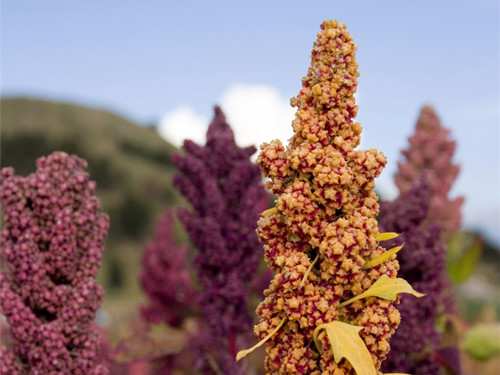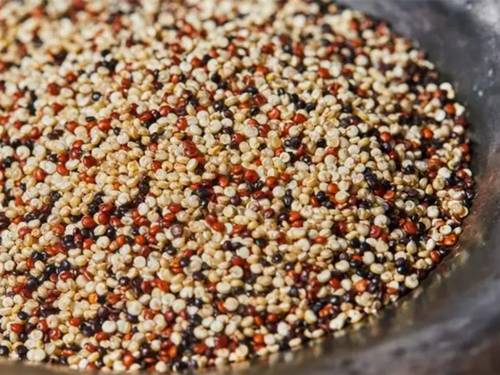Quinoa originated in the Andes mountains of South America, is the traditional food of the Inca indigenous people, and has various effects such as protein supplements, endocrine regulation, blood sugar-regulating and cholesterol-reducing and so on. Some people think quinoa is a member of the rice family, while it’s actually more similar to buckwheat. Quinoa extracts such as quinoa protein and quinoa oil have been widely used in hair and skin care products in recent years. Why?
Firstly, let’s take a look at quinoa’s protein content. Protein is one of the main nutrients needed to treat various health problems. According to the types and quantities of amino acids contained in food protein, food protein can be divided into three types: complete protein, semi-complete protein and incomplete protein. A complete protein is a kind of high-quality protein, that contains all kinds of essential amino acids with sufficient quantity, and appropriate proportion, quinoa protein can not only maintain human health but also promote growth and development. Proteins in milk, eggs, fish and meat are all complete proteins. Quinoa’s protein content averages 16 percent (and can be as high as 22 percent), which is unusual for a plant.

Quinoa plant
Quinoa contains seventeen essential amino acids for infants and young children, especially lysine, which is needed for tissue growth and repair and is lacking in regular grains. It has a cationic structure that helps it attach hydrolyzates to your hair. The hydrolyzed form of the grain is highly absorbent, so it can provide the moisture needed beneath the cuticle of your hair. These lipids create a protective barrier for your hair and promote shine and bounce. In addition, quinoa is an excellent conditioning agent. It helps add shine to hair and improves curl definition. Because of its high protein content, it pairs well with other ingredients in your hair care routine.
Quinoa has the same protein quality and content as skim milk powder and meat, making it the best choice for vegetarians and a great alternative to grains like rice. You can harvest proteins and other ingredients from quinoa to improve the condition of hair follicles. It provides a natural mild coating that nourishes the hair follicles without harming them. Therefore, nutritionists suggest eating foods rich in plant protein to restore dry and damaged hair.
At the same time, quinoa is full of micronutrients, which are essential for healthy hair. Quinoa is high in iron, four times higher than wheat. Iron is an indispensable trace element for human health. Iron deficiency can cause a variety of tissue changes and dysfunction, such as affecting the development of lymphatic tissue and resistance to infection. The amount of iron in an adult’s body is about 3g to 5G, two-thirds of which is concentrated in hemoglobin. The reason why hemoglobin can transport oxygen to every cell in the body and carry away CO2 produced by each cell in the process of metabolism is closely related to its composition containing iron. Iron deficiency is easy to cause iron deficiency anemia and hair loss.
When taken orally, you take rich microelement when taking in Quinoa, Selenium is honored as a “longevity element” by medical and nutritionists at home and abroad. Quinoa’s selenium element, vitamin E, β -carotene and so on are higher than ordinary grain, and it is a rare antioxidant food. Plus, quinoa is loaded with fiber. Quinoa contains almost twice as much fiber as brown rice, oats and other grains. These advantages make quinoa hair care popular.
Of course, you can use quinoa products for your health. Quinoa seed oil is a great addition to your shampoo and contains humectants that help retain moisture in your hair. This is especially beneficial for those with dry or damaged hair. Additionally, quinoa oil for your scalp has niacin, which improves blood circulation. This improves the flow of oxygen and nutrients throughout your scalp and hydrates your hair. Furthermore, quinoa seed oil helps to prevent the recurrence of split ends.
Quinoa oil for hair is rich in antioxidants and has a moisturizing effect, which means that it helps keep your hair moisturized and protects it from heat damage. It also has a high elasticity and porosity, which makes it easy to detangle and style. In addition, quinoa contains humectants, which play an important role in keeping your scalp and hair hydrated. They form a protective film over your hair, making it easy to brush and manage and helping protect hair from damage, reducing the appearance of split ends and dandruff. In addition, quinoa can be combined with a good serum to improve your hair’s luster and elasticity. It also strengthens the roots of your hair, which prevents hair from falling out. In addition, quinoa has been shown to improve elasticity and prevent frizz.
- Dandelion Extract: What It Is, Benefits, Uses and Side Effect - April 23, 2024
- Is Berberine Extract Help For Weight Loss? - April 11, 2024
- Why Is Pysllium Husk Powder A Popular Meal Replacement Ingredient? - April 3, 2024



